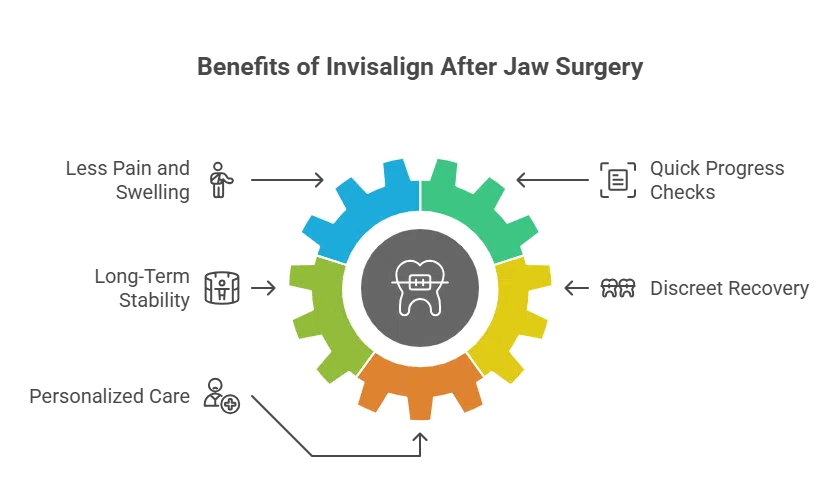Patients and families often wonder: Can Invisalign be used after jaw surgery? Yes, Invisalign can often be used after jaw surgery, but it depends on your healing, bone stability, and your dentist or orthodontist’s evaluation. In Weymouth, MA, Comfort Dental Weymouth provides comprehensive orthodontic care that combines cutting-edge technology with surgical treatment plans. Jaw surgery (orthognathic surgery) is performed to correct severe skeletal bite issues that cannot be fixed with braces or aligners alone. After such surgery, the teeth still need minor adjustments to achieve a perfect bite, and this is where orthodontic treatment like Invisalign® can play a role. In many cases, advanced orthodontists use Invisalign clear aligners after orthognathic surgery to finalize tooth alignment and restore smiles.
Patients in Weymouth who undergo corrective jaw surgery can often continue with Invisalign treatment afterward. Orthognathic surgery (jaw surgery) repositions the jawbones to fix an open bite, underbite, or other severe malocclusion. After surgery, orthodontic fine-tuning is usually needed to complete the bite correction. Comfort Dental Weymouth’s experienced team works closely with oral surgeons to plan each patient’s treatment.
Understanding Jaw Surgery (Orthognathic Surgery)
Jaw surgery is a specialized operation performed by oral and maxillofacial surgeons to correct mismatches in the jawbones. It is typically recommended only for adults (when growth is complete) who have significant bite problems that braces alone cannot fix. For example, a severe underbite (Class III malocclusion) or an open bite often requires surgery to align the jaws properly. In this procedure, the surgeon makes cuts in the upper jaw, lower jaw, or both, and repositions them to improve function and facial symmetry. Plates or screws hold the bones in place while healing.
Most orthognathic surgeries are done under general anesthesia in a hospital setting. Patients usually stay 1–2 days post-operation and follow a soft diet during initial healing. Normal jaw movement and speech often recover within 2–3 weeks, and full recovery takes around 6 weeks. While surgery fixes the jawbone position immediately, the teeth often require further adjustment. Braces or aligners are then used to fine-tune the bite once the jaws are stable. This final orthodontic phase is crucial for achieving optimal results.
Why Jaw Surgery Is Performed
Jaw surgery addresses underlying skeletal issues, not just the teeth. Common reasons for orthognathic surgery include:
- Severe underbite or overbite that causes difficulty chewing or speaking.
- Open bite where front teeth do not meet even when the back teeth do.
- Crossbite or asymmetry due to misaligned jaw growth.
- Sleep apnea correction (in some cases, moving jaws can improve airway).
- Chronic jaw pain or TMJ issues stemming from imbalance.
These conditions often have a significant functional or aesthetic impact. Comfort Dental Weymouth ensures that patients requiring surgery are evaluated by an oral surgeon, and that orthodontic needs (like Invisalign or braces) are coordinated before and after surgery.
Orthodontics and Jaw Surgery
After jaw surgery, patients enter the post-surgical orthodontic phase. Traditionally, braces are placed before surgery to align the teeth in each jaw (a process called decompensation) and after surgery to finalize the bite. However, modern treatment plans can incorporate Invisalign clear aligners instead of traditional braces for many patients.
Braces vs. Invisalign After Surgery
There are two main options for aligning teeth before/after jaw surgery:
- Traditional Braces: Metal or ceramic brackets and wires are the conventional choice. They give orthodontists precise control, especially in complex cases. Braces must stay on during the surgical phase and typically remain for about 6 months after surgery to settle the bite.
- Invisalign Clear Aligners: These are nearly invisible plastic trays customized to fit over the teeth. They gradually shift teeth when worn 20–22 hours a day. With proper planning, Invisalign can replace braces in many surgical cases. Advanced 3D imaging is used to create a detailed Invisalign plan that works with the surgical plan.
Experts note that Invisalign is not only for mild cases. While Invisalign is most commonly used for mild-to-moderate misalignments, it can be part of treatment for more severe problems when combined with surgery.
Invisalign aligners are custom-made and removable, making them a convenient option for active Weymouth patients. After surgery, using aligners means patients can eat and clean their teeth more easily during the recovery period. However, the orthodontist must carefully time when the patient transitions to aligners. Typically, Invisalign treatment can begin a few weeks after surgery once the jaws are stabilized.
Invisalign and Orthognathic Surgery
The combination of Invisalign with jaw surgery is often referred to as surgical orthodontics. In this approach, the Invisalign system is integrated into the overall treatment plan:
- Pre-Surgical Phase: Clear aligners (or braces) may be worn to position the teeth so that they fit correctly after the jaws are repositioned. In some cases, Invisalign may be worn leading up to surgery.
- Surgery: Orthognathic surgery is performed with the aligners (or braces) in place or with an interim surgical splint.
- Post-Surgical Phase: Once initial healing occurs, Invisalign is resumed to fine-tune tooth position.
Recent clinical reports support this approach. For example, one study notes that “the Invisalign system can be effectively employed for orthodontic treatment in combination with orthognathic surgery”. In practice, this means that after Comfort Dental Weymouth coordinates with the surgeon, Invisalign can complete the smile makeover without the need for metal braces.
Using Invisalign After Jaw Surgery
For patients who qualify, Invisalign offers several advantages after jaw surgery:
- Comfort: The smooth plastic causes less irritation than metal brackets, which is beneficial when swelling and sensitivity are present post-op.
- Aesthetics: Patients can maintain a normal appearance during treatment, which may be important for social and professional reasons.
- Hygiene: Removable aligners allow easier brushing and flossing, helping recovery and reducing the risk of gum issues.
- Treatment Control: Modern Invisalign attachments (small bumps on teeth) and elastics can provide precise movements even after surgery.
However, certain factors must be considered:
- Patient Compliance: The success of Invisalign hinges on wearing the aligners as prescribed (about 22 hours a day). Comfort Dental educates patients on following instructions closely.
- Treatment Complexity: Very complex tooth movements may still require temporary braces or additional appliances.
- Orthodontist Expertise: Skilled providers at Comfort Dental Weymouth use 3D planning and may incorporate attachments or elastics with Invisalign to address challenging movements.
Consultation and Treatment Planning
The first step is a thorough evaluation. Comfort Dental Weymouth will perform a comprehensive exam, including digital scans and X-rays, to assess teeth and jaw structure. They will then consult with your oral surgeon. Together, they develop a custom treatment plan that may blend Invisalign with surgical steps.
In this planning stage, the orthodontist determines:
- The timing of surgery relative to aligner treatment.
- Whether any pre-surgery aligner or braces phase is needed.
- How many aligners will be needed in total.
- If any additional tools (like anchor pins or elastics) are required.
A clear orthodontic plan ensures that post-surgery, the Invisalign system seamlessly continues where the surgery left off. Digital 3D models allow the team to simulate tooth movements through each aligner, ensuring the new jaw position is respected.
Timeline for Invisalign Post-Surgery
Every patient’s timeline is unique, but here’s a general sequence:
- Pre-Surgery Orthodontics: If needed, the patient may wear Invisalign (or braces) before surgery for several months to align the teeth segments properly.
- Jaw Surgery: The surgical procedure is carried out with the orthodontic appliance in place, or with a surgical splint prepared in advance.
- Immediate Post-Op: Jaw is immobilized for initial healing. Typically, no tooth movement until after surgical splint removal (usually within 1–2 weeks).
- Recovery Period: A soft diet and rest for about 2–3 weeks as initial healing occurs.
- Resuming Invisalign: Around 3–6 weeks post-op (depending on the case), the patient begins wearing their next set of Invisalign trays. This can be a “re-scan” mid-treatment or continuation of a planned aligner series.
- Finishing Bite: Over the next several months (often 3–6 months), Invisalign aligners gradually finalize the bite. Comfort Dental Weymouth will schedule regular check-ups (every 6–8 weeks) to monitor progress and make adjustments if necessary.
- Retention: Once active treatment is done, retainers (custom clear retainers) are provided to keep teeth in position.
Benefits of Invisalign Post-Surgery
By choosing Invisalign after jaw surgery, patients enjoy benefits that may make recovery and daily life easier:
- Less Pain and Swelling: Without the metal hardware of braces, there is often less gum irritation. Some studies even suggest Invisalign patients experience less post-op swelling compared to braces patients (though individual experiences vary).
- Quick Progress Checks: Digital aligners allow Comfort Dental to adjust the treatment plan on-the-fly with new scans, ensuring high accuracy in the final months.
- Long-Term Stability: Because Invisalign trays fit snugly and require commitment, patient compliance tends to be good, which can lead to more stable results.
- Discreet Recovery: Right after surgery, having no visible braces can boost confidence as swelling subsides and during social interactions.
Comfort Dental Weymouth emphasizes personalized care. The orthodontist may incorporate attachments or use elastics with Invisalign to manage specific movements that typically needed braces in the past. In one severe case example (from another practice), a patient with an underbite underwent Invisalign treatment for 24 months (55 upper, 60 lower aligners) and achieved a corrected bite. That illustrates the potential when treatment is carefully managed.
Comfort Dental Weymouth’s Expertise
Comfort Dental Weymouth serves the South Shore of Massachusetts and has a reputation for blending advanced orthodontics with patient-focused care. Our Weymouth practice offers the latest Invisalign technology and works seamlessly with local oral surgeons. Here’s how we help patients with jaw surgery needs:
- Collaborative Care: We coordinate with top oral surgeons in Massachusetts to plan each surgical orthodontic case. This includes joint planning sessions so that Invisalign treatment is integrated into the surgical timeline.
- State-of-the-Art Technology: We use 3D digital scanners and treatment simulation software to visualize how teeth will move post-surgery. This precision planning can reduce surprises and help patients understand each step.
- Comfort and Education: Our team prepares patients for what to expect in recovery and aligns expectations. We provide instructions on aligner wear, oral hygiene, and diet during the healing phase.
- Lifelong Support: After treatment, we help patients maintain their results with custom retainers and routine check-ups. We also address any TMJ or bite concerns that may arise.
At Comfort Dental Weymouth, patient stories speak for our success. Many Weymouth patients have reported great satisfaction using Invisalign after jaw surgery, appreciating the balance of comfort and results. One Weymouth patient noted how quickly they transitioned back to daily life without the inconvenience of braces, while still achieving a beautifully aligned smile.
Key Takeaway: If you’ve had orthognathic surgery or are planning it, ask your Weymouth orthodontist about Invisalign. It’s increasingly common and can be a suitable option for achieving the final results you want.
People Also Ask
- Can I still use Invisalign after corrective jaw surgery?
Yes. Many patients continue or start Invisalign treatment after orthognathic surgery. Modern orthodontists use Invisalign for post-surgery tooth alignment as long as the jaw bones are stable. - How soon after jaw surgery can I get Invisalign aligners?
After surgery, you’ll need a short healing period. Typically, Invisalign can begin 3–6 weeks post-op, once swelling has reduced and the surgeon gives the go-ahead. Your orthodontist and surgeon will determine the exact timing based on your case. - Do I need braces or Invisalign after jaw surgery?
It depends on your preference and orthodontist’s recommendation. Some providers prefer braces, but Invisalign is often an effective alternative. Comfort Dental Weymouth’s orthodontists will advise which is best for your specific bite and lifestyle. - Will Invisalign be effective for my bite after jaw surgery?
Generally yes, for finishing alignment. Jaw surgery fixes the bones; Invisalign fine-tunes the teeth. Invisalign works well for most bite corrections after surgery, especially if the jaws are now aligned properly. - Is Invisalign pain-free after jaw surgery?
Invisalign tends to cause minimal discomfort. You might feel pressure each time you switch to a new aligner, but this is usually mild and less irritating than metal braces. This gentler approach can make post-surgery recovery more comfortable. - How long does Invisalign treatment take after jaw surgery?
Treatment time varies by case complexity. Many post-surgery patients finish Invisalign in about 6–12 months of active aligner therapy. Your orthodontist will give you an estimate based on your initial plan. - Can Invisalign correct jaw alignment problems?
Invisalign itself cannot move the jaw bones. Only surgery can correct skeletal jaw issues. However, Invisalign corrects the tooth positions on those repositioned jaws. - Are clear aligners better than braces after jaw surgery?
For many patients, yes. Aligners offer comfort and aesthetics. But braces may still be recommended for extremely complex movements. Comfort Dental Weymouth will assess which method provides the best control and outcome. - What if Invisalign is not enough after surgery?
If Invisalign alone is insufficient for any reason, alternatives include traditional braces or additional orthodontic appliances. In some cases, minor surgical adjustments or refinements might be needed. - How do I find out if I’m a candidate for Invisalign post-surgery?
Schedule a consultation at Comfort Dental Weymouth. We will examine your teeth and jaw (with scans and X-rays) to see if Invisalign fits your post-surgery needs. A tailored evaluation is the best way to determine candidacy.
Frequently Asked Questions (FAQs)
- What is orthognathic (jaw) surgery?
Orthognathic surgery is an operation to correct jawbone misalignment. It repositions the upper and/or lower jaw to improve bite and facial harmony. It’s typically done when braces alone cannot correct severe underbites, overbites, or open bites. - Why might I need jaw surgery before Invisalign?
If your bite discrepancy is due to jaw positioning, surgery will fix that underlying issue. After surgery, Invisalign can then properly align the teeth on the corrected jaw structure. Without surgery, Invisalign alone may not achieve a stable bite in severe skeletal cases. - How is Invisalign treatment planned around surgery?
An orthodontist and surgeon jointly plan the sequence. Often, some Invisalign aligners are worn before surgery, then paused during surgery healing, and resumed after. Digital models help coordinate tooth movements with the new jaw position. - Will I be without any orthodontic treatment during jaw surgery recovery?
During the first few weeks after surgery, you typically won’t wear any aligners to allow swelling to go down. Once healing begins (usually 2–4 weeks post-op), you will continue with your next set of Invisalign trays under orthodontic supervision. - Is it normal to need braces again after jaw surgery?
It’s common to require orthodontic treatment (braces or aligners) after surgery to finish bite alignment. This is a normal part of surgical orthodontics. Many patients prefer Invisalign at this stage due to comfort and appearance. - Will Invisalign fix my speech issues after jaw surgery?
Jaw surgery often improves speech by correcting bite. Invisalign then aligns teeth for optimal bite function. Both together typically result in clearer speech and better chewing. - Do I have to wear a retainer after Invisalign post-surgery?
Yes. After any Invisalign treatment, including post-surgery, a retainer is worn to keep teeth from shifting back. Comfort Dental Weymouth provides custom retainers and instructs patients on long-term retainer wear for lasting results. - Is Invisalign suitable for all ages after jaw surgery?
Invisalign is suitable for teenagers and adults. Jaw surgery is rarely done before growth completion, so most patients are adults or late teens. Age isn’t a major factor beyond that; suitability depends on the specific bite issue, not age. - Can insurance cover Invisalign after jaw surgery?
Many dental plans cover a portion of orthodontic treatment (braces or Invisalign) if it’s deemed medically necessary. Since jaw surgery with orthodontics is a functional treatment, insurance may help cover costs. Check your specific plan. - How much does Invisalign after jaw surgery cost?
Costs vary by case complexity and region. Post-surgery Invisalign often costs similarly to regular Invisalign treatment (several thousand dollars). Consult Comfort Dental Weymouth for a detailed estimate. A financing plan or insurance coverage may help manage expenses.
Final Thoughts
In summary, yes, Invisalign can often be used after jaw surgery for patients in Weymouth, MA. Combining orthognathic surgery with Invisalign is a sophisticated treatment approach that yields great results when managed by experienced professionals. Comfort Dental Weymouth is committed to guiding you through this process, from surgery referral to final smile alignment. By partnering with skilled surgeons and using advanced Invisalign technology, our team ensures you achieve a healthy, beautiful bite after jaw surgery. If you are looking for a Weymouth dentist near you, please visit Comfort Dental Weymouth, 47 Washington St, Weymouth, MA 02188, (781) 337-3300.







































